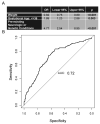Risk Factors Associated with Mechanical Ventilation in Critical Bronchiolitis
- PMID: 34828749
- PMCID: PMC8618830
- DOI: 10.3390/children8111035
Risk Factors Associated with Mechanical Ventilation in Critical Bronchiolitis
Abstract
The American Academy of Pediatrics (AAP) recommends supportive care for the management of bronchiolitis. However, patients admitted to the intensive care unit with severe (critical) bronchiolitis define a unique group with varying needs for both non-invasive and invasive respiratory support. Currently, no guidance exists to help clinicians discern who will progress to invasive mechanical support. Here, we sought to identify key clinical features that distinguish pediatric patients with critical bronchiolitis requiring invasive mechanical ventilation from those that did not. We conducted a retrospective cohort study at a tertiary pediatric medical center. Children ≤2 years old admitted to the pediatric intensive care unit (PICU) from January 2015 to December 2019 with acute bronchiolitis were studied. Patients were divided into non-invasive respiratory support (NRS) and invasive mechanical ventilation (IMV) groups; the IMV group was further subdivided depending on timing of intubation relative to PICU admission. Of the 573 qualifying patients, 133 (23%) required invasive mechanical ventilation. Median age and weight were lower in the IMV group, while incidence of prematurity and pre-existing neurologic or genetic conditions were higher compared to the NRS group. Multi-microbial pneumonias were diagnosed more commonly in the IMV group, in turn associated with higher severity of illness scores, longer PICU lengths of stay, and more antibiotic usage. Within the IMV group, those intubated earlier had a shorter duration of mechanical ventilation and PICU length of stay, associated with lower pathogen load and, in turn, shorter antibiotic duration. Taken together, our data reveal that critically ill patients with bronchiolitis who require mechanical ventilation possess high risk features, including younger age, history of prematurity, neurologic or genetic co-morbidities, and a propensity for multi-microbial infections.
Keywords: acute respiratory failure; bacterial pneumonia; critical bronchiolitis; invasive mechanical ventilation; non-invasive respiratory support.
Conflict of interest statement
The authors have no conflict of interest to disclose.
Figures


References
LinkOut - more resources
Full Text Sources
Miscellaneous

